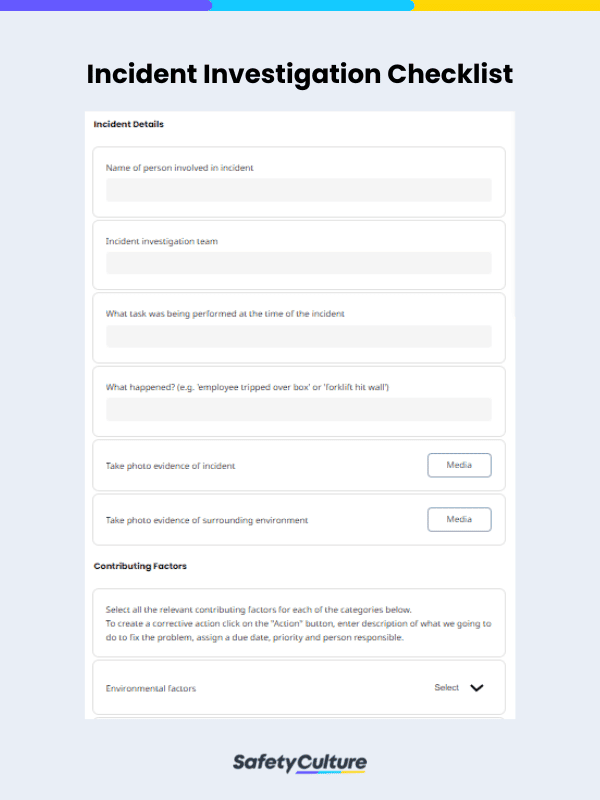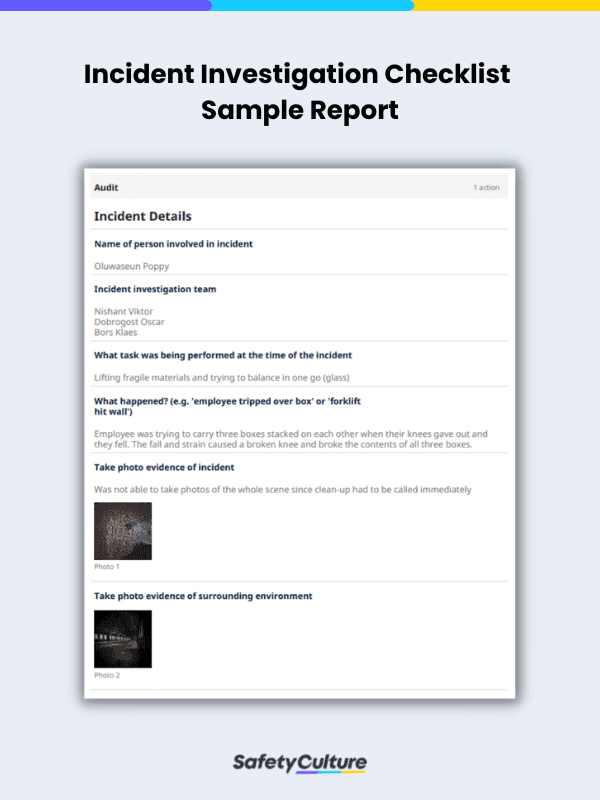What is an Incident Investigation Checklist?
An incident investigation checklist is a standardized form or list that guides people in investigating, identifying, documenting, and analyzing an incident. This kind of checklist can help you ensure that all relevant information to an incident is gathered and that no critical details are missed during the investigation.
Importance and Benefits
In a work setting, having an incident investigation checklist with you in your organization is an important aspect of incident management and workplace safety. By thoroughly investigating incidents, organizations can determine the underlying causes and take corrective action to prevent similar incidents from occurring in the future. A well-done incident investigation checklist provides a structured approach to investigating incidents and analyzing the contributing factors that lead to the event. It can also help identify and correct hazards that contribute to accidents and near-misses.
Moreover, an incident investigation checklist can also aid organizations in complying with local and international safety standards. Some safety organizations require the presence of a dedicated checklist to report incidents, not just for incident management but also for recordkeeping purposes. Some of the well-known safety organizations that mandate incident investigation checklists as a requirement are the US Occupational Safety and Health Administration (OSHA), the Canadian Centre for Occupational Health and Safety (CCOHS), and Safe Work Australia (SWA).
Additionally, an incident investigation checklist can also help safety officers and managers with the following:
- Ensure that all necessary steps are taken during the investigation process.
- Promote consistency in the investigation process.
- Help identify underlying issues and trends.
- Identify areas for improvement in workplace safety policies, procedures, and training programs.
Types
Incident investigation checklists can come in many formats depending on your needs. They can be divided into two types: basic and advanced checklists.
The easiest kind of incident investigation checklist to use create is a basic and simple one. As its name suggests, this checklist only has the key elements of an incident investigation checklist, such as incident details, witness statements, sequence of events, contributing factors, and the corrective actions to be taken or already done.
Compared to a basic checklist, an advanced incident investigation checklist requires more details. It has additional sections and questions to guide the investigation process, such as sections for recording evidence, interviews, and photographs.
Both types can come in different forms, such as those in log sheets, notebooks, and books. However, the best kind of incident investigation checklist is one that would be used digitally, specifically the ones that can be accessed anytime and anywhere. These checklists provide the added benefit of real-time data collection and analysis. Digital checklists also allow for automated data entry and report generation, which are essential when reporting ongoing incidents or sending them across far distances.
What Should an Incident Investigation Checklist Include?
An effective incident investigation checklist should include the following key elements:
- Incident details: The checklist should include a section for recording the incident details, such as the date, time, location, and what was happening before, during, and after. If possible, also strive to get statements from injured folk and witnesses for additional clarity.
- Contributing factors: Make sure to also include a section for identifying the contributing factors that led to the incident, such as equipment, environment, work systems, and other human factors.
- Corrective actions: The checklist should include a section for recording corrective actions that have been taken or need to be taken to prevent similar incidents from occurring in the future.
- Reporters’ details: Finish off your incident investigation checklist with the details of whoever is in charge of reporting, responsible for the area, or those involved in the incident itself. This will allow other members of management to know exactly who to call for additional details, compensation, and support later on as necessary.
How to Use an Incident Investigation Checklist
According to OSHA, there are three main elements to conducting an incident investigation in the workplace. These are:
- Preparation: This is where incident prevention and mitigation training is provided to managers, workers, and safety professionals. Part of this process involves identifying what documents will be needed when reporting and documenting an incident, so this is also where you will be creating and finalizing your incident investigation checklist with the help of those around you.
- On-site investigation: This is where you are now fully utilizing your checklist. You or your workers will be investigating the incident at hand directly and will need to document it. If you are often on the go and working in high-risk areas, having a digital checklist would be best, as you can ensure that your files will be stored in the cloud and available for easy access anytime and anywhere. A digital checklist can also allow you to capture evidence, such as photos, to better help in documentation.
- Development of a report: Now that you have filled up your incident investigation checklist, it is time to save it for recordkeeping along with other reports you might need for documentation and creating formal incident reports. It is essential to store your checklist somewhere safe, preferably in the cloud, so you can always refer back to it anytime you need it, especially for future recommendations.
Here is a sample report of how an incident investigation checklist can look like:
Common Mistakes to Avoid
When creating and using your incident investigation checklist, you may make some mistakes. Some of the common ones to avoid are:
- Failing to assign responsibilities: If the guidelines for using the checklist and the responsibilities associated with it are not clearly assigned, it can be easy for the incident investigation steps to be overlooked or duplicated. Properly orienting your workers on the importance of incident investigation checklists and how to use them is a must.
- Overreliance on the checklist: While the incident investigation checklist is a valuable tool in maintaining workplace safety, it is important to also use your professional judgment and experience to make decisions. Don’t simply rely on the checklist.
- Not documenting everything: Failure to document all information gathered, decisions made, and actions taken can make it difficult to identify underlying issues and trends. Additionally, if you do not review your checklist after the incident investigation, it can be difficult to identify areas for improvement and update your records as needed.
- Not using a template: To save time and work more efficiently, consider using or creating a template for your incident investigation checklist. With a template, you can conduct incident investigations quicker, as everything will be ready from the start.
FAQs about Incident Investigation Checklists
Ideally, an incident investigation should be conducted by the organization’s management, the members of its safety community, and its union steward or representative. However, depending on the situation, others involved in the incident can also create their own checklists, as they are also witnesses.
The best times an incident investigation can be conducted are when:
- The incident just happened
- The scene of the incident is still left uncleaned or untouched after
- The victims of the incident can still remember what happened
Yes, an incident investigation checklist can be used in any workplace. Although more known and used in high-risk areas such as construction and mining sites, low-risk workplaces such as indoor offices are still at risk for different incidents, so having an incident investigation checklist is still important.




